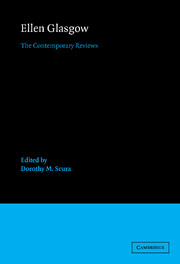Book contents
- Frontmatter
- Contents
- Series Editor's Preface
- Preface
- Acknowledgments
- Introduction
- The Descendant (1897)
- Phases of an Inferior Planet (1898)
- The Voice of the People (1900)
- The Battle-Ground (1902)
- The Freeman and Other Poems (1902)
- The Deliverance (1904)
- The Wheel of Life (1906)
- The Ancient Law (1908)
- The Romance of a Plain Man (1909)
- The Miller of Old Church (1911)
- Virginia (1913)
- Life and Gabriella (1916)
- The Builders (1919)
- One Man in His Time (1922)
- The Shadowy Third and Other Stories (1923)
- Barren Ground (1925)
- The Romantic Comedians (1926)
- They Stooped to Folly (1929)
- The Sheltered Life (1932)
- The Old Dominion Edition of the Works of Ellen Glasgow (1929-33)
- Vein of Iron (1935)
- The Virginia Edition of the Works of Ellen Glasgow (1938)
- In This Our Life (1941)
- A Certain Measure (1943)
- Index
The Miller of Old Church (1911)
Published online by Cambridge University Press: 04 May 2010
- Frontmatter
- Contents
- Series Editor's Preface
- Preface
- Acknowledgments
- Introduction
- The Descendant (1897)
- Phases of an Inferior Planet (1898)
- The Voice of the People (1900)
- The Battle-Ground (1902)
- The Freeman and Other Poems (1902)
- The Deliverance (1904)
- The Wheel of Life (1906)
- The Ancient Law (1908)
- The Romance of a Plain Man (1909)
- The Miller of Old Church (1911)
- Virginia (1913)
- Life and Gabriella (1916)
- The Builders (1919)
- One Man in His Time (1922)
- The Shadowy Third and Other Stories (1923)
- Barren Ground (1925)
- The Romantic Comedians (1926)
- They Stooped to Folly (1929)
- The Sheltered Life (1932)
- The Old Dominion Edition of the Works of Ellen Glasgow (1929-33)
- Vein of Iron (1935)
- The Virginia Edition of the Works of Ellen Glasgow (1938)
- In This Our Life (1941)
- A Certain Measure (1943)
- Index
Summary
“Among the Books,” Richmond Times-Dispatch, 5 June 1911, p. 5
The Miller of Old Church is strong in its realism, like all of Miss Glasgow's work, and broad in its grasp. It is far more than a Virginia classic, for its divining touch in relation to life indicates the motive power by which all humanity is swayed. In the purpose and consistency of its portrayal it resembles the Deliverance more nearly than any of her other previous books.
“The Miller of Old Church”, New York Times Saturday Review of Books, 11 June 1911, p. 372
Miss Glasgow long ago proved herself to be not only a novelist whose books are interesting enough to attract at once a wide circle of readers, but also one worthy to be counted in that small group of contemporary American fictionists whose work really counts and is likely to last longer than her own generation. In her new book she has added another to her graphic pictures of Southern life and Southern people. Its scene is laid in Virginia in the period following the civil war, when the bonds that held together the older social organization were breaking under the stress of change and readjustment, and in the unaccustomed equality of opportunities those who formerly would have had but little chance were acquiring wealth and political power. Abel Revercomb is “the miller” of the story and he is one of the most outstanding and interesting of all the many Southern plain-folk characters Miss Glasgow has pictured so vividly.
- Type
- Chapter
- Information
- Ellen GlasgowThe Contemporary Reviews, pp. 145 - 154Publisher: Cambridge University PressPrint publication year: 1992



